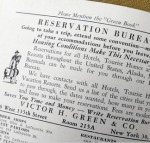
During the Jim Crow era in the United States, it was neither easy nor safe for African-Americans to travel from town to town. For three decades,
The Negro Motorist Green Book: An International Travel Guide was an indispensable resource for finding a place to stay, eat, or buy gas in towns across America. Not necessarily the
best places, but
any place that would provide accommodations
at all if you weren’t white.
A Harlem postal employee and civic leader named Victor H. Green conceived the guide in response to one too many accounts of humiliation or violence where discrimination continued to hold strong. These were facts of life not only in the Jim Crow South, but in all parts of the country, where black travelers never knew where they would be welcome. Over time its full title — “The Negro Motorist Green Book: An International Travel Guide” — became abbreviated, simply, as the “Green Book.” Those who needed to know about it knew about it. To much of the rest of America it was invisible, and by 1964, when the last edition was published, it slipped through the cracks into history.
The Green Book has been revived in a way, as a new play and a children’s book about the travel guide and those who used it are set to debut.
 During the Jim Crow era in the United States, it was neither easy nor safe for African-Americans to travel from town to town. For three decades, The Negro Motorist Green Book: An International Travel Guide was an indispensable resource for finding a place to stay, eat, or buy gas in towns across America. Not necessarily the best places, but any place that would provide accommodations at all if you weren’t white.
During the Jim Crow era in the United States, it was neither easy nor safe for African-Americans to travel from town to town. For three decades, The Negro Motorist Green Book: An International Travel Guide was an indispensable resource for finding a place to stay, eat, or buy gas in towns across America. Not necessarily the best places, but any place that would provide accommodations at all if you weren’t white.
No comments:
Post a Comment